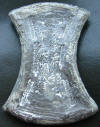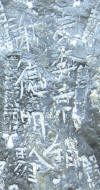Wheat Season of the Southern Areas to the Yangtze River
Weight: 450 grams/12.5 taels
Date: N/A
Inscriptions by Stamping:
霸北街西/重拾 貳兩半/霸北街西
West of Ba Bei Street (Address of the silver shop where was in the capital Ling An (Now, Hangzhou))
Weighed Twelve and a Half Taels
Additional Inscriptions by Stamping:
鎮江劉鋪( Zhenjiang, Liu Firm)
Additional Inscriptions by Engraving:
麥季京銷/謝德明驗
Cast in the Capital City in the Wheat Season
Assayed by Hsieh Der Ming
In the regions
between Yangtze River and Huai River,
"Wheat Season" means the 5th month in the celestial calendar. But,
why "Wheat" Season?
An old Chinese saying "北人食麥.南人食米"(Northerners eat
wheat; Southerners eat rice) articulates vividly the different customs, major
agricultural products and tastes of foods between the Chinese people
living north and south of the Yangtze River. The Southern Sung
silver shown, according to its inscriptions, was cast and circulated in Hangzhou and
Zhenjiang, which were both south of the Yangtze River. It is intriguing that the
additional inscriptions
麥季京銷 (Cast in the
Capital City in the Wheat Season) seem to imply
wheat was commonly grown in the south. It would contradict the old
proverb,
as well as most people's belief.
We were not able to solve this apparent contradition until we found an article "江南地区的粮食亩产及其估算方法辨析"(A Discussion on the Per Mu Grain Yield in the South of the Yangtze in the Song Dynasty and the Method of Its Estimation) authored by 葛金芳 Ge Jin-fang (湖北大学,人文学院,湖北,武汉; School of Humanities, Hubei University, Wuhan, Hubei 430062, China)
In that article, there are a few paragraphs which can offer a solution.
During the turn of the Northern and Southern Sung Dynasties, many Chinese living in the north who were used to food made of wheat were forced to immigrate to the south, as a result, the demand for wheat sharply increased and the price rose in the southern areas. Farmers were encouraged to grow wheat by the potential to reap tremendous profits.
In the Southern Sung, Zhuang Ji Yu mentioned in his work 《鸡肋编》:After the reign of Jien Yen (1127-1130), Jiangsu, Chekiang, Hunan, Hubei, Fujien, Kuangtung were all crowded with immigrants from the north and west. During the rise of Hsao Xing (1131-1162), 10 Chinese catties of wheat was sold for 12,000 cash, and the profit generated was double that from growing rice. During spring time, the scenery was just like in the north, since wheat was growing everywhere.
In addition to the profit protential, the fact that farmers did not need to submit wheat to landlords could be a more important incentive for tenants in the south, since they were only required to submit rice as rent. (Original Chinese texts in below)
Therefore, since wheat became a revolutionary agricultural product to the Chinese during the Southern Sung Dynasty, it is no wonder that people would name this specific time of year as "Wheat Season", instead of "Rice Season".
两宋之际大批北人南渡,北人嗜面,南方各地对小麦的需求大幅度上升,价格随之高涨,种麦有利可图,这就大大刺激了农夫种麦的积极性。南宋庄季裕在《鸡肋编》中说:
建炎(1127~1130年)以后,江浙、湖湘、闽广,西北流寓之人遍满。绍兴(1131~1162年)初,麦一斛至万二千钱,农获其利,倍于种稻。……(各地)竞种春稼(麦),极目不减淮北。
除了价格因素以外,江南佃户种麦积极性空前高涨,还有一个更为重要的原因,这就是佃农"惟是种麦不用还租,租得一石是一石"。(《黄氏日钞》卷78)其实并非种麦不用交租,而是自来租佃惯例只交水稻一茬之租,在水稻之外抢收一茬小麦就全归佃农所得了。这就极大地刺激了无地佃农实施稻麦连作的积极性。前引庄季裕《鸡肋编》在谈到江浙、湖湘、闽广等地普遍种麦后,又说:"而佃户输租者只有秋课,种麦之利,独归客户。"广大佃农在这场耕作制度的革命中,显然获得了极大的经济利益,这是一年二熟制在江南地区得以迅速推广的又一重要动因。换言之,广大佃农是这场耕制革命的主力军。
Return to Sycee Talks

